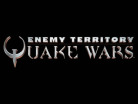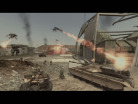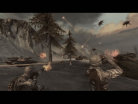- CLASSIC MAGAZINES
- REVIEW CREW
A show recapping what critics thought back
when classic games first came out! - NEXT GENERATION'S BEST & WORST
From the worst 1-star reviews to the best
5-stars can offer, this is Next Generation! - NINTENDO POWER (ARCHIVE)
Experience a variety of shows looking at the
often baffling history of Nintendo Power! - MAGAZINE RETROSPECTIVE
We're looking at the absolutely true history of
some of the most iconic game magazines ever! - SUPER PLAY'S TOP 600
The longest and most ambitious Super NES
countdown on the internet! - THEY SAID WHAT?
Debunking predictions and gossip found
in classic video game magazines! - NEXT GENERATION UNCOVERED
Cyril is back in this spin-off series, featuring the
cover critic review the art of Next Generation! - HARDCORE GAMER MAGAZING (PDF ISSUES)
Download all 36 issues of Hardcore Gamer
Magazine and relive the fun in PDF form!
- REVIEW CREW
- ELECTRONIC GAMING MONTHLY
- ELECTRONIC GAMING MONTHLY RANKS
From Mario to Sonic to Street Fighter, EGM
ranks classic game franchises and consoles! - ELECTRONIC GAMING MONTHLY BEST & WORST
Counting down EGM’s best and worst reviews
going year by year, from 1989 – 2009! - ELECTRONIC GAMING BEST & WORST AWARDS
11-part video series chronicling the ups and
downs of EGM’s Best & Worst Awards!
- ELECTRONIC GAMING MONTHLY RANKS
- GAME HISTORY
- GAME OVER: STORY BREAKDOWNS
Long-running series breaking down game
stories and analyzing their endings! - A BRIEF HISTORY OF GAMING w/ [NAME HERE]
Real history presented in a fun and pithy
format from a variety of game historians! - THE BLACK SHEEP
A series looking back at the black sheep
entries in popular game franchises! - INSTANT EXPERT
Everything you could possibly want to know
about a wide variety of gaming topics! - FREEZE FRAME
When something familiar happens in the games
industry, we're there to take a picture! - I'VE GOT YOUR NUMBER
Learn real video game history through a series
of number-themed episodes, starting at zero! - GREAT MOMENTS IN BAD ACTING
A joyous celebration of some of gaming's
absolute worst voice acting!
- GAME OVER: STORY BREAKDOWNS
- POPULAR SHOWS
- DG NEWS w/ LORNE RISELEY
Newsman Lorne Riseley hosts a regular
series looking at the hottest gaming news! - REVIEW REWIND
Cyril replays a game he reviewed 10+ years
ago to see if he got it right or wrong! - ON-RUNNING FEUDS
Defunct Games' longest-running show, with
editorials, observations and other fun oddities! - DEFUNCT GAMES QUIZ (ARCHIVE)
From online quizzes to game shows, we're
putting your video game knowledge to the test!- QUIZ: ONLINE PASS
Take a weekly quiz to see how well you know
the news and current gaming events! - QUIZ: KNOW THE GAME
One-on-one quiz show where contestants
find out if they actually know classic games! - QUIZ: THE LEADERBOARD
Can you guess the game based on the classic
review? Find out with The Leaderboard!
- QUIZ: ONLINE PASS
- DEFUNCT GAMES VS.
Cyril and the Defunct Games staff isn't afraid
to choose their favorite games and more! - CYRIL READS WORLDS OF POWER
Defunct Games recreates classic game
novelizations through the audio book format!
- DG NEWS w/ LORNE RISELEY
- COMEDY
- GAME EXPECTANCY
How long will your favorite hero live? We crunch
the numbers in this series about dying! - VIDEO GAME ADVICE
Famous game characters answer real personal
advice questions with a humorous slant! - FAKE GAMES: GUERILLA SCRAPBOOK
A long-running series about fake games and
the people who love them (covers included)! - WORST GAME EVER
A contest that attempts to create the worst
video game ever made, complete with covers! - LEVEL 1 STORIES
Literature based on the first stages of some
of your favorite classic video games! - THE COVER CRITIC
One of Defunct Games' earliest shows, Cover
Critic digs up some of the worst box art ever! - COMMERCIAL BREAK
Take a trip through some of the best and
worst video game advertisements of all time! - COMIC BOOK MODS
You've never seen comics like this before.
A curious mix of rewritten video game comics!
- GAME EXPECTANCY
- SERIES ARCHIVE
- NINTENDO SWITCH ONLINE ARCHIVE
A regularly-updated list of every Nintendo
Switch Online release, plus links to review! - PLAYSTATION PLUS CLASSIC ARCHIVE
A comprehensive list of every PlayStation
Plus classic release, including links! - RETRO-BIT PUBLISHING ARCHIVE
A regularly-updated list of every Retro-Bit
game released! - REVIEW MARATHONS w/ ADAM WALLACE
Join critic Adam Wallace as he takes us on a
classic review marathon with different themes!- DEFUNCT GAMES GOLF CLUB
Adam Wallace takes to the links to slice his way
through 72 classic golf game reviews! - 007 IN PIXELS
Adam Wallace takes on the world's greatest spy
as he reviews 15 weeks of James Bond games! - A SALUTE TO VAMPIRES
Adam Wallace is sinking his teeth into a series
covering Castlevania, BloodRayne and more! - CAPCOM'S CURSE
Adam Wallace is celebrating 13 days of Halloween
with a line-up of Capcom's scariest games! - THE FALL OF SUPERMAN
Adam Wallace is a man of steel for playing
some of the absolute worst Superman games! - THE 31 GAMES OF HALLOWEEN
Adam Wallace spends every day of October afraid
as he reviews some of the scariest games ever! - 12 WEEKS OF STAR TREK
Adam Wallace boldly goes where no critic has
gone before in this Star Trek marathon!
- DEFUNCT GAMES GOLF CLUB
- DAYS OF CHRISTMAS (ARCHIVE)
Annual holiday series with themed-episodes
that date all the way back to 2001!- 2015: 30 Ridiculous Retro Rumors
- 2014: 29 Magazines of Christmas
- 2013: 29 Questionable Power-Ups of Christmas
- 2012: 34 Theme Songs of Christmas
- 2011: 32 Game Endings of Christmas
- 2010: 31 Bonus Levels of Christmas
- 2009: 30 Genres of Christmas
- 2008: 29 Controls of Christmas
- 2007: 34 Cliches of Christmas
- 2006: 33 Consoles of Christmas
- 2005: 32 Articles of Christmas
- 2004: 31 Websites of Christmas
- 2003: 29 Issues of Christmas
- 2002: 28 Years of Christmas
- 2001: 33 Days of Christmas
- NINTENDO SWITCH ONLINE ARCHIVE
- REVIEW ARCHIVE
- FULL ARCHIVE
Enemy Territory: Quake Wars
On the PC, Enemy Territory: Quake Wars was a compelling alternative to EA's Battlefield franchise. This Activision game managed to combine a science fiction shooter with the wide-open landscapes of Battlefield. It offered exciting objectives, huge battles, tons of vehicles and some sharp looking graphics. It wasn't a perfect game, but Quake Wars on the PC was a solid game that was easy to recommend. Unfortunately this Xbox 360 port (coming eight months after the original PC game) is not as easy to recommend.
The set-up is simple, the alien (known as the Strogg) has attacked Earth in order to process a specific material into some sort of fuel. The humans (known as the GDF) are understandably defensive about this invasion, so the two sides duke it out to decide who will control this planet. Or something like that, the truth is that the story is largely irrelevant in the context of this game. Outside of the opening cinema, you never really get much added story, so you shouldn't come into Quake Wars expecting this to advance the Quake narrative.
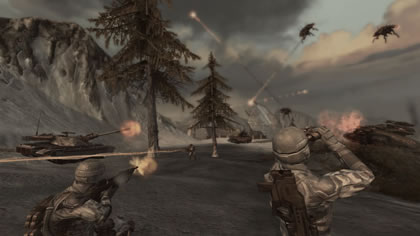
You also shouldn't expect a big focus on the single-player modes, because Enemy Territory: Quake Wars was designed primarily for online play. This is a class-based first-person shooter, not unlike Team Fortress 2 and the Battlefield series. One side plays as the GDF and the other side is the Strogg, each side has their own unique objective and whoever is able to complete it first is the winner. Once the round has come to an end all 16 players filter back into a lobby and then jump right back into the game. There's a little more to it than that, but that is the basic concept behind Quake Wars.
The missions are all pretty simple, so it's easy for just about anybody to jump into a match and know what they're supposed to be doing. The average mission involves an engineer building something useful, a soldier blowing something up and a covert ops agent rushing into a base and getting intel. There are also missions where you'll need to drive a tank (or some large, slow-moving vehicle) into the enemy base while taking enemy fire, the object here is to constantly kill the enemy, repair the tank and keep it moving forward. Each one of the game's dozen maps has you completing (or at least trying to complete) three or four of these tasks, so there's always something to do.
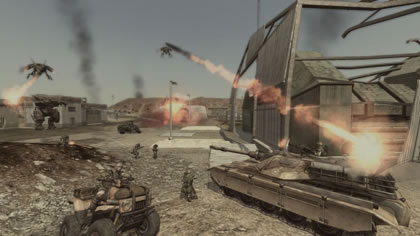
The nice thing about these different tasks is that you only have to take on one at a time, that way you have all of the action taking place in just one section of the map. This definitely keeps things exciting, especially when the two sides are fighting over something as simple as building a bridge from one island to another. Best of all, as people complete the various missions the actual battles with move, so that you're always be fighting at a new location, which goes a long way to improving the lasting value of each level.
In the single-player modes these tasks are well defined, you know that you have to pick the right kind of class (which you can switch at any time) and that you have to lead your team into battle to complete these missions. But things are a little more freeform online. You still have the tasks, but the game doesn't require you to lead your team into battle. Instead you can be one of those followers that plays back-up, laying down land mines, building anti-personnel turrets and throwing down health packets. When you play in a full room (that's eight players versus eight players) you have a lot more options; it's online that the classes really come into focus.
For the most part both sides have the same classes, even if they are called by different names. If you're a fan of class-based shooters then you will feel right at home with Quake Wars. Most of the classes feel like they were lifted from a half dozen other games, which isn't a bad thing when you're trying to appeal to a broad group of gamers. You have your basic soldiers (who can set up detonation devices and have more health), the medic (which can revive fallen teammates and resupply bullets to those in need), the engineer (who can build super powerful turrets), the covert ops (a sniper class that can steal enemy secrets), and field ops (a powerful scouting class).
The Strogg also has these classes, but that doesn't mean that there aren't some important differences. For example, a Strogg medic (known as a "technician") can revive fallen comrades and give health packets to their teammates, as well as create spawn hosts out of the bodies of their enemies. Other Strogg characters can build crazy units and other useful things. Best of all, the Strogg have these jet packs that allow you to fly high up into the sky so that you can see the battlefield and move about quickly. There are certainly pros and cons either way you go, so it's important for you to check out both the GDF and the Strogg to see which one you prefer.

Unfortunately the developers behind this Xbox 360 port (Nerve Software) decided against telling anybody how to get the most out of these different classes. There is a tutorial; however it shows you only the most basic moves. What it needed to do is elaborate a little more on how each class is different and their many pros and cons. For that you have to dig out the instruction manual and do a little studying. Or, since my copy came with the official Brady Games strategy guide, you could also check out somebody's guide or FAQ. Either way, there are a lot of aspects of this game that should have been explained in the game. Once you get the hang of the game Quake Wars proves to be a fun game that anybody can play, it's just getting over that learning curve that will turn a lot of players off.
While the game comes with a campaign mode, the name itself is a bit of a misnomer. This isn't a campaign; it's basically just an elaborate tutorial mode to teach you what to do when you go online. Each of the 12 levels have the same missions you find online, so it basically just boils down to you and 15 other bots going through the motions in hopes of winning. As a way to teach you how to play the game online this campaign mode is fantastic, however it's disappointing that there wasn't more of an effort made to give this a real story and some importance.
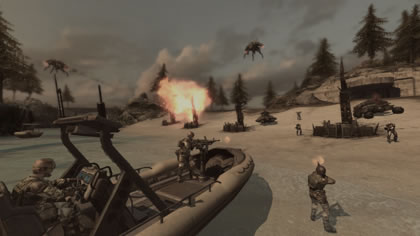
Of course, the real fun and excitement comes from taking this game online. This game was, of course, meant to be a large-scale multiplayer game, so it shouldn't surprise anybody that this is what it's good at. Online you can do all of the crazy things you did in the campaign mode, including driving vehicles (on the land, air and sea), blowing all sorts of things up and taking over the enemy bases. If you're the kind of player who loves team-based first-person shooters then you owe it to yourself to check out Quake Wars.
But this game does not come without a few major flaws. Apparently Activision didn't learn the lesson of Shadowrun; last year's poorly received online-only first-person shooter. I'm certainly not the kind of person that is against an multiplayer focused shooter, but if that what you're going to give me, then you better make sure you offer enough maps to keep me busy for months to come. Sadly this is not what Activision has done in Enemy Territory: Quake Wars.
For sixty dollars you get 12 maps, each one with the exact same objectives every time you play. This isn't like Halo 3 or Call of Duty 4 where you can play a bunch of different game types on one level, instead you have very specific goals that never change. What's more, these levels found in this Xbox 360 port don't even feature all of the side missions (a staple of the original PC version). If you fall in love with the way the game plays and it's exciting battles then you will be able to overlook the lack of maps, but this is yet another online game that skimps on the content.
As a PC game Quake Wars offered epic battles, featuring 16 vs. 16 fights. Unfortunately that's not the case in this Xbox 360 port. For whatever reason this game only features the 8 on 8 battles, which means that half of the players have been deleted from the battlefield. It's clear when playing this game (even with the maximum amount of players) that these levels were made to support more players. It's a shame that Activision couldn't figure out a way of allowing more players in a room, I have a hunch that this game would be even better with twice the amount of people.
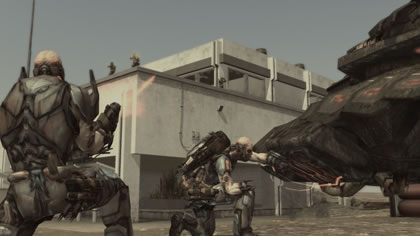
There are a few other problems, but nothing you can't get over. One thing you can't complain about are the controls, which are well laid out and responsive. The one thing I immediately noticed about this game is just how fast it moves; perhaps I have been playing too many slow console first person shooter games (Halo, Call of Duty, Half-Life, etc.), because I was shocked at how quick everything was in Quake Wars. There are a few layout changes that I would have liked, but the game controls well and is fun to play.
The graphics are also sharp, even if they don't look nearly as good as the original PC game. The 12 different levels are split up into four different locations (North America, Africa, Europe and the Pacific). These different regions are cool looking, even if they include a lot of places we've been before in other games. The wide-open environments hold up and there are enough landmarks in each level to keep you from getting lost. These aren't the best graphics around, but you're moving so fast that you'll hardly even notice.
All in all Enemy Territory: Quake Wars is a solid first-person shooter that is different enough from the competition to make it worth looking into. That doesn't mean that it's perfect, because this game has a few problems that may be deal breakers for some people. But I had a good time shooting down flying Strogg soldiers and infiltrating all of their secrets. Maybe I shouldn't be reviewing this game based on what it's not, even when it can't quite reach the high standards of the PC original. Sadly, even based on what it is this game comes up a little short.
HOME |
CONTACT |
NOW HIRING |
WHAT IS DEFUNCT GAMES? |
NINTENDO SWITCH ONLINE |
RETRO-BIT PUBLISHING
Retro-Bit |
Switch Planet |
The Halcyon Show |
Same Name, Different Game |
Dragnix |
Press the Buttons
Game Zone Online | Hardcore Gamer | The Dreamcast Junkyard | Video Game Blogger
Dr Strife | Games For Lunch | Mondo Cool Cast | Boxed Pixels | Sega CD Universe | Gaming Trend
Game Zone Online | Hardcore Gamer | The Dreamcast Junkyard | Video Game Blogger
Dr Strife | Games For Lunch | Mondo Cool Cast | Boxed Pixels | Sega CD Universe | Gaming Trend
Copyright © 2001-2025 Defunct Games
All rights reserved. All trademarks are properties of their respective owners.
All rights reserved. All trademarks are properties of their respective owners.







